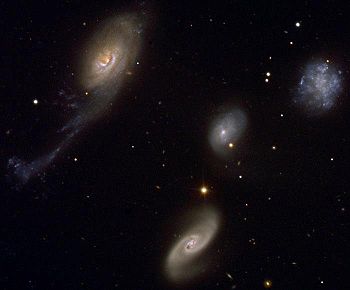NGC 92
| Galaxy data from NGC 92 |
|
|---|---|
| Roberts Quartet consisting of NGC 87 (top right), NGC 88 (center), NGC 89 (bottom) and NGC 92 (top left). | |
| AladinLite | |
| Constellation | Phoenix |
|
Position equinox : J2000.0 , epoch : J2000.0 |
|
| Right ascension | 00 h 21 m 31.7 s |
| declination | -48 ° 37 ′ 29 ″ |
| Appearance | |
| Morphological type | SAa: / pec / LINER |
| Brightness (visual) | 12.9 mag |
| Brightness (B-band) | 13.8 mag |
| Angular expansion | 1.9 ′ × 0.9 ′ |
| Position angle | 148 ° |
| Surface brightness | 13.3 mag / arcmin² |
| Physical data | |
| Affiliation | Roberts Quartet |
| Redshift | 0.010737 +/- 0.000022 |
| Radial velocity | 3219 ± 7 km / s |
|
Stroke distance v rad / H 0 |
(141 ± 10) x 10 6 ly (43.2 ± 3.0) Mpc |
| history | |
| discovery | John Herschel |
| Discovery date | September 30, 1834 |
| Catalog names | |
| NGC 92 • PGC 1388 • ESO 194-12 • 2MASX J00213171-4837292 • GC 46 • h 2319 • AM 0018-485 | |
NGC 92 is an interacting spiral galaxy in the constellation Phoenix . It is about 141 million light years away from the Milky Way , with a diameter of about 80,000 light years. Together with NGC 87 , NGC 88 , NGC 89 , this galaxy forms the Roberts Quartet galaxy group . Their distorted appearance (especially the 100,000 light-year long arms ) is most likely due to gravitational interaction with their neighbors.
The galaxy NGC 92 was discovered on September 30, 1834 by the British astronomer John Frederick William Herschel .
Web links
- Capella Observatory
- ESO: Cosmic Portrait of a Perturbed Family November 4, 2005

